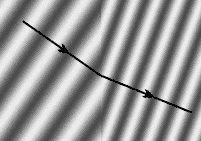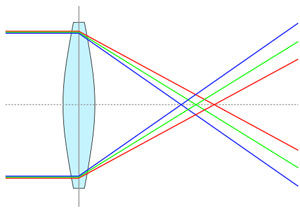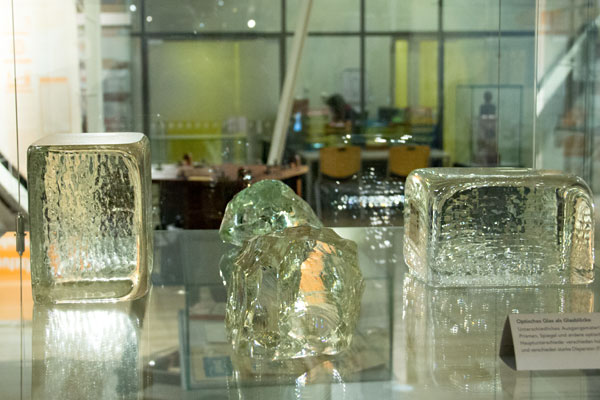Refraction
Refraction is a phenomenon of waves changing direction when passing from one medium to another. In a photographic lens that is the case when passing from air to glass and again from glass to air. It occurs also when passing from one type of glass to a different one. They are not all the same as we will see below.
The ability to change light direction is crucial for any image making device. That is because light rays diverge into space and, in order to form images, a lens must have them converging again, that means, changing direction.

The physical cause of refraction is a change in light speed. Light has its maximum speed vacuum, less in air and even lesser in glass. That, combined with the wave nature of light, leads to a change in the direction in which it propagates.

The above animation shows wavefronts (we may think them as rows of soldiers marching), coming down from left to right. They have a certain speed and direction indicated by the arrow. As soon as they reach the second half in our window of observation the speed diminishes (we can think the soldiers entered a swamp or any difficult soil). That could be light passing from air to glass. The number of rows entering from the left equals the number or rows leaving on the right (soldiers or wavefronts do not vanish). So, as a consequence of a lower speed we have that the wavefronts get more compact (the wavelength shortened) and there is a change in direction because not all the wavefronts diminished speed at the same time.
Would the direction of rays be perpendicular to the border between the two zones with different speeds, then there would be no change in direction. That is the case when light reaches the glass with a perpendicular direction.
The amount of light bending depends on how much the speed changes and the angle of incidence of light. The speed change is dependent on the medium in which it propagates. Each transparent material has a Refractive Index, the more it reduces light speed the higher its Refractive Index.
When changing from air to glass (higher to lower speed) the light beam gets closer to a perpendicular at the point of incidence.
When changing from glass to air (lower to higher speed) the light beam gets farther to the perpendicular at the point of incidence.
Dispersion
Dispersion is the phenomenon caused by refractive index being different for different light colors (wavelengths). That produces the effect that a beam of white light, after refracting on glass “disperses” into different directions showing a patch of different colors. That is what we can observe with a prism.

Dispersion and Refractive indexes are characteristics of glass and vary from one to another. So they are selected according to the ends of specific usages. High refraction and high dispersion are desirable for prisms, when color separation is important. In lenses, high dispersion worsen chromatism, that is the effect of a lens not being able to focus all colors at once in one single focus plane. Some colors focus at shorter distances and others at longer distances. The figure below illustrates that effect.

We may think of a bi-convex lens as a composition of infinite micro prisms arranged in a certain shape. So the same effect of color separation produced by a prism can be expected to occur for each beam of white light reaching a small portion of that lens. The result is a not well defined focus point. That is Chromatic Aberration.
All glasses have a certain amount of refractive and dispersion indexes. What lens designers do is to combine different glasses and shapes aiming to preserve a converging power, to form images, while producing a lens that works as if dispersion did not exist, an Achromatic lens.
Optical Glass
Glass is basically silicon dioxide SiO2, being silicon one of the most common elements on Earth and in the Universe. Glass is also known from very ancient times in many different cultures. But optical glass is a development that started not earlier than the XVIIIth century. First problems were about getting rid of bubbles and striae, or having a clear and pure glass. Second issue was about controlling its optical qualities, being Refractive and Dispersion indexes the most important variables. Also stability, resistance to environment, abrasion, easiness of manufacturing were, of course, considered.
What changes from one optical glass to another is the addition of small quantities of substances like lead, zirconium, titanium, lanthanum and barium, among others, generally in form of oxides. With these ingredients, optical glass makers can offer a variety of glasses ranging from low refractive and dispersion indexes, generally named Crown Glass to higher refractive and dispersion indexes, known as Flint Glass.
The progress in lens design has always been dependent on the available glasses for opticians to work with. For instance, the famous solution provided by Paul Rudolph in designing the first high aperture anastigmats in 1890 was possible only because new barium crown glasses started to be produced in Jena.

Samples of optical glass – Optik Industrie Museum – Rathenow, Germany.
Comment with just one click.
Was this article useful for you? [ratings]